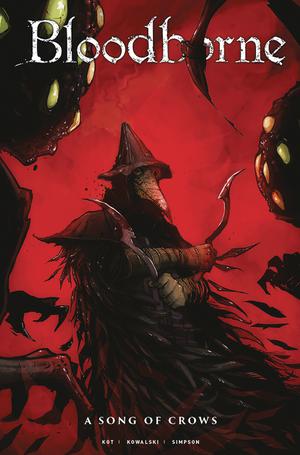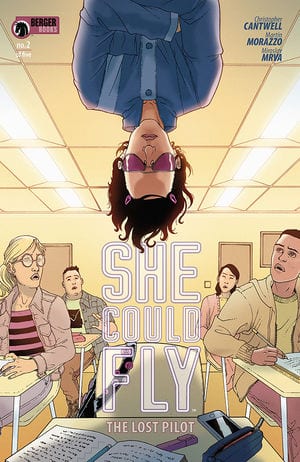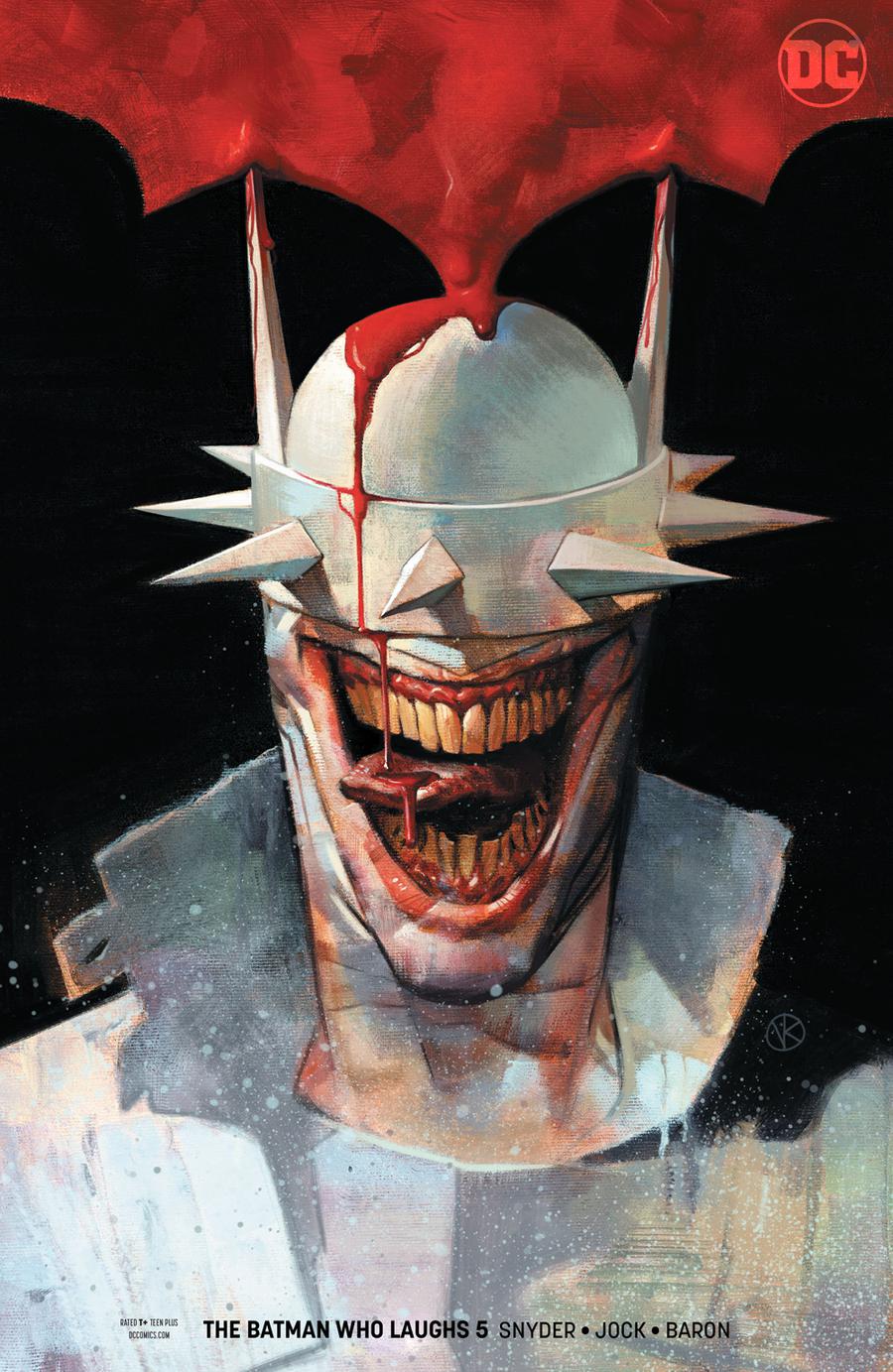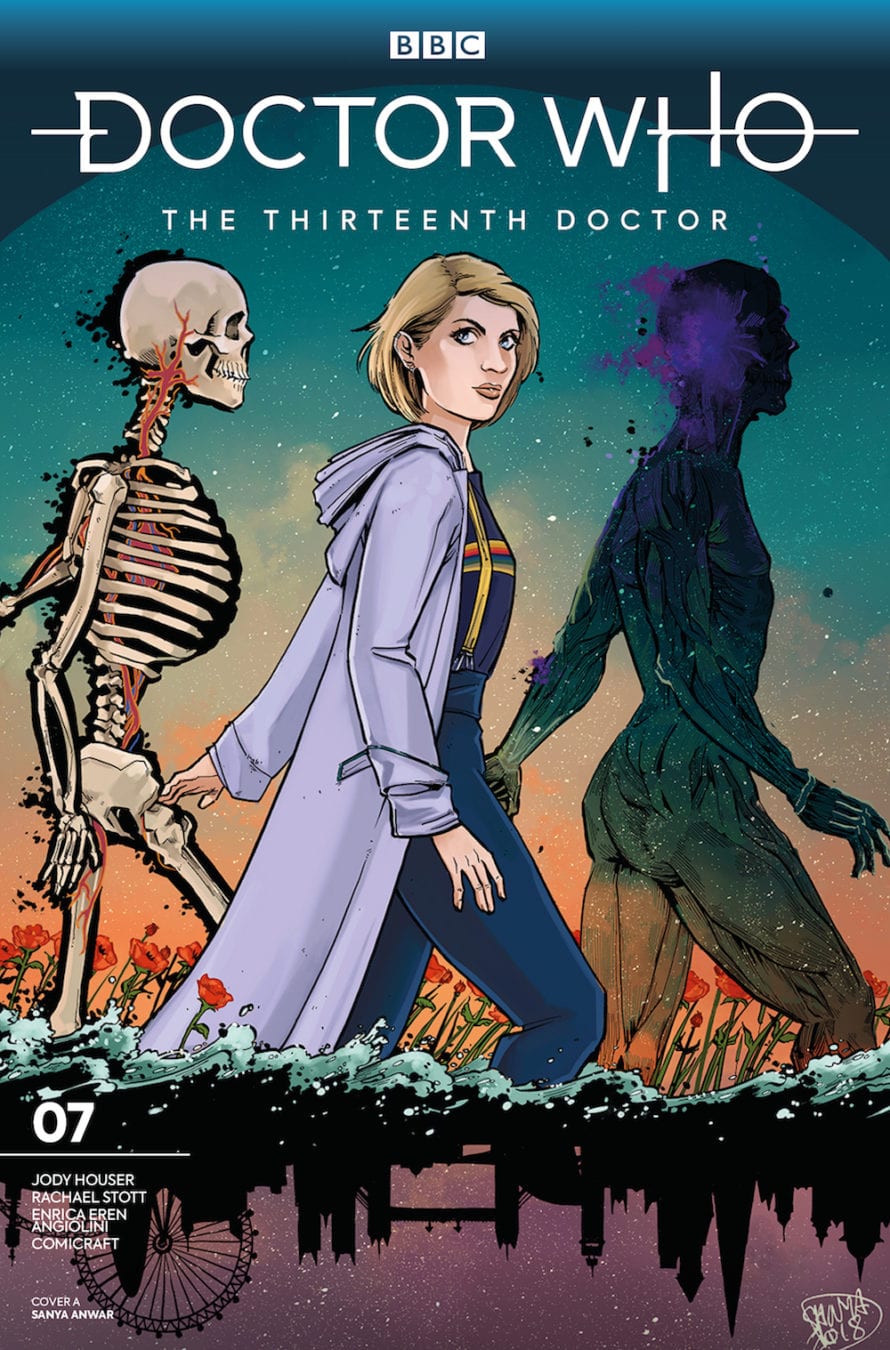Review: Faithless #2 (of 5)
Brian Azzarello and Maria Llovett’s walk, or perhaps trip, on the wild side continues this
Brian Azzarello and Maria Llovett’s walk, or perhaps trip, on the wild side continues this
We“re back in the land of Animosity, a world where sentience doesn’t just belong to
STORY Super Sikh is the story of Deep Singh, a super secret agent and part
Synopsis: Ah, Thank God for Boom studios. The original Planet of the Apes is one
STORY From the creator of Naruto comes a new series and this time its about
The Terminus Agenda has ultimately been a story of loss, or more specifically processing loss. Far beyond the obvious loss of life, the Terminus Agenda deals with the loss of trust and it deals with that loss up close and personal as it pertains to each of these characters.Pursuant to the dramatic events of Deathstroke #43, this issue addresses the immediate effects of Red Arrow’s coup de grace delivered via an expertly placed arrow through Slade Wilson’s patched eye. However, as status quo shattering as that is, Damian’s betrayal of trust in keeping a secret prison beneath Teen Titans headquarters looms even larger in the teams collective estimation. Adam Glass astutely examines the emotional stakes in this epilogue to the crossover event that has apparently taken Deathstroke out of the game completely or certainly sidelined him for the foreseeable future at the very least.
Over the span of his career Glass has become known for his meticulous character development, particularly through his talent for writing authentic and captivating dialogue. That is especially true of this issue where the writer finds the voice of each of these very diverse characters and does so with unmistakable personality. More than the sum of the individual parts, Teen Titans has a collective heart that beats through each of these dynamic characters. Damian’s actions have threatened to tear that heart out of the team by creating circumstances so divisive that several lines have been drawn in the proverbial sand. Though his upbringing at Bruce’s side speaks volumes in defense of Damian’s actions, or at least in explanation of his questionable actions, it certainly does speak to the method to his madness or one could just as readily see it as the madness in his methods. Either way there is no question that Damien’s tutelage under Bruce, even more so than their oft times strained father/son relationship, has shaped the hero the young man has become. In the case of the other Teen Titans Glass relies heavily on their interactions with Damian as a team leader, not only through his stellar dialogue, but through the tension created and built upon as the issue unfolds. Each team member has a fully developed perspective that differs by degrees from one another, perhaps the most poignant is Djinn’s since she has had the experience of being imprisoned herself. This is not a unique perspective to her character, as Damian and Kid Flash have certainly experienced imprisonment, but to a far less extent. In Djinn’s case, however her experience sets her firmly in opposition to Damian and his secret prison, finding the very concept inhumane. This casts Robin as the antagonist of the narrative and once more overshadows Emiko’s rogue action that ended Deathstroke’s life.
Adam Glass does a solid job of transitioning from the crossover into what is to become something of a new status quo for the Teen Titans. He makes brilliant character choices that open some very intriguing doors for these dynamic young characters. Crush plays a major role in events going forward as becomes terrifyingly clear, especially for her, in the final page reveal. Overall the Terminus Agenda including the epilogue was an unqualified success, this is due in large part to the seamless collaborative effort between Glass and Deathstroke scribe, Priest. The two titles worked hand in glove to tell a complex, intriguing and intricately crafted story. Stylistically the narrative unfolded without a hitch, the pace was even and the action exciting throughout. I’m a huge fan of the Deathstroke series, so when this arc was originally revealed my interested was piqued to say the least. The creative teams involved on both titles executed very well and the resulting story speaks for itself.
[gallery ids="150116,150117,150118,150119,150120,150121,150115"]Visually, Bernard Chang’s artwork is absolutely gorgeous on this issue. His action sequences are among the best in the business and he pulls out all the stops in this one. There is a visual poetry to his work that presents the big action in such a nuanced manner that the fight scenes take on a stunning graceful appearance that is far superior to the industry standard fare. The colors are explosive in this issue and simply pop right off the page. Marcelo Maiolo and Hi-Fi work some serious comic book magic with the hues, tints and shades. There is a heighten intensity that comes from such vivacious coloring and it really ups the ante here resulting in a much more exciting finished work.
Overall, Teen Titans #30 is an extremely satisfying ending to the Terminus Agenda, but even more than that it is an exciting beginning to the next chapter for the Tenn Titans. This is an emotionally charged issue full of complex story beats and deep interpersonal elements. Adam Glass delivers some superb character work, while Bernard Chang and company knock the visuals over the center field wall. 4.5/5
Writer- Adam Glass
Artist- Bernard Chang
Colors- Mercelo Maiolo & Hi-Fi
Letterer- Rob LeighÂ
From the beginning off the Song of Crows storyline Ales Kot tells you the direction he intended to take Blood Borne,  in issue #9 part 1 of Song of Crows : “No matter how hard you try to understand you will never know the whole story. You may even choose to convince yourself that you’ve found the right angle from which to see the totality of the world.”
in issue #9 part 1 of Song of Crows : “No matter how hard you try to understand you will never know the whole story. You may even choose to convince yourself that you’ve found the right angle from which to see the totality of the world.”
I like puzzles…I fail miserably at them but But hey I’m going to give this Bloodborne book a try! At first glance there are various underlying story-lines that definitely helps out if you read the previous story arcs or at least had finished the game.
In the video game Eileen the Crow is a hunter tasked with slaying hunters who have gone blood-drunk and sub-sequentially mad and violent from Beast Hunting. That’s why one of the first panels we saw in issue #9 was intriguing because we see the body of the Hunter the death of sleep storyline. The last we heard of the Hunter (last heard of in issue #4) and the Paleblood child was in Blood Borne 4 (No sign of the pale blood child though). But the most interesting thing was a note found in the mouth of one of the bodies that said ” Consciousness is a lake”. To which Eileen replied that ” There’s a hole in the center of the story”. Later on in issue #10 Eileen is freaking a passage from a book that says ” come and see your grief the gate”.
The Song of Crows storyline has been a chance for Piotr Kowalski to show of his skills of letting the art tell the story. With zero dialogue it was left up to the reader to make the connection between the art and the panels and the exposition layed neatly by letterer Aditya Bidikar.
Over the last couple of days I keep re-opening the issue to see what I may have missed but instead I kept finding myself distracted by the beauty of the panels.
As a speculator I don’t have much fidelity on a really big reason to collect the Bloodborne comic series yet have her I am encouraged by Sony`s willingness to expand the products associated with the Bloodborne franchise. It seems Blood Borne is getting an official board game adaptation thanks to a Kickstarter campaign  that has already surpassed  $200,000. So I have to ask what’s next for Bloodeborne? A movie ala Silent Hill?
The title of the first story arc in Image“s groundbreaking series, BITTER ROOT is “Family
So I’ve read a couple of issue’s of Calamity Kate and decided to hold off
People of a certain age are fond of saying that “your school days were the
After the bloody ending to Orphan Age #1 this second installment slows things down a
Bruce Banner is trapped inside Shadow Base Site A – powerless and hunted by their
Kickstarters are a great place to try your hand at creating something. In this case
What an emotional week of comics for me. I do not say this lightly when
A couple of years back, The Random Dude Josh invited me onto the UCPN podcast
Synopsis: The Scourging of Shu Torun part IV: The Galactic Empire was able to launch
 Berger Books/Dark Horse’s SHE COULD FLY is an astonishing exploration into the realm of human psychology and mental health. If you missed the first mini-series (2018), you will need it to best appreciate and understand Luna’s journey. The second, mini – SHE COULD FLY: Lost Pilot – starts off where readers were left at the conclusion of the first arc. Luna is in a mental hospital and the amazing cast of characters that Chris Cantwell and company have developed around her, are worse for the mental wear that accrues to the kinds of things they have all experienced up to this point.
Berger Books/Dark Horse’s SHE COULD FLY is an astonishing exploration into the realm of human psychology and mental health. If you missed the first mini-series (2018), you will need it to best appreciate and understand Luna’s journey. The second, mini – SHE COULD FLY: Lost Pilot – starts off where readers were left at the conclusion of the first arc. Luna is in a mental hospital and the amazing cast of characters that Chris Cantwell and company have developed around her, are worse for the mental wear that accrues to the kinds of things they have all experienced up to this point.
At the center of the story is Mayura Howard, a mysterious woman who made significant advancements in technology that allowed her to fly – until that tech failed her. Luna bore witness to Mayura’s ascendance, but her own unusual mental state was altered/enhanced in the process. So far Luna has been diagnosed with schizophrenia and by the time we get to the second issue of “The Lost Pilot†the good doctors have added hypomania to the list of mental challenges she is facing. The unpronounceable meds she is being prescribed feigns a sense of light-heartedness, but this book is weighty in all of the right places. There are government conspiracies, international espionage and plenty of heads that get blown off. But the substance of SHE COULD FLY resides in the minds of its characters, many of whom suffer from mental maladies that in our real world would be ignored or (over) medicated, but in Cantwell’s world, mental health (or the absence of it) is depicted through a compellingly holistic frame.
Chapter Two of “The Lost Pilot†opens in a dream sequence in the mind of Luna. One of Luna’s abilities allows her to commune with the dead – or at least think that she can commune with the dead. In the opening dream sequence she sits “Indian style†with Joan of Arc as they eat yellow wallpaper and talk about boys throughout history that they may or may not like. It’s a brilliant opener – even for a series that has too many classic panels/images to recount in one review. Martin Morazzo and Miroslav Mrva have given this book a distinct look that always feels familiar. Its as if the visual art of SHE COULD FLY is actually in on the mind-bending effects of the story, except that the art works those effects on the reader as much as it does on the characters in the story itself.
There is an important research paper/project to be written about this dream sequence with Luna and Joan of Arc chatting and eating the yellow wallpaper. Charlotte Perkins Gilman’s classic short story, “The Yellow Wallpaper,†was published in 1892. Yet it still resonates as a referendum on how mental health is (mis)treated and particularly how women who have mental health challenges are treated in medical institutions and by the society in which we live. There is much more to say about this short story and these panels from SHE COULD FLY.
This will read as hyperbole. It isn’t. The author’s note section of this series, “In-Flight†is the bravest and at times the most powerful addenda that any writer is making to their work in comics right now. SHE COULD FLY’s value does not rely on Chris Cantwell’s “In-Flight†notes, but readers will be edified and inspired by them. Here’s a snippet from #4 of the first story arc: “[T]here’s this idea going around that comics can’t be good and about real things and reflect the real world at the same time (unless the characters are white men). I just want to say that’s bullshit. Stories are power, and empowering. Drama assembles the simultaneous chaos of life into order, or at least some semblance of meaning. And when I say that, I don’t mean it’s a message, I mean it’s a mirror.†5/5!
[yasr_overall_rating size=”large”]
Writer: Christopher Cantwell
Artist: Martin Morazzo
Colorist: Miroslav Mrva
Editor: Karen Berger
Cover Artist: Martin Morazzo
 In the last issue of Batman starts the process that would turn him into a diversion at the Batman who laughs can see and hear and must think like the Batman who laughs who has up to this point and one step ahead. This time Batman’s plan to stay to try to keep up with the Batman mask results in the murdering of Commissioner Gordon, and now the Gotham police had turned their guns on Batman in order to avenge Commissioner Gordon.
In the last issue of Batman starts the process that would turn him into a diversion at the Batman who laughs can see and hear and must think like the Batman who laughs who has up to this point and one step ahead. This time Batman’s plan to stay to try to keep up with the Batman mask results in the murdering of Commissioner Gordon, and now the Gotham police had turned their guns on Batman in order to avenge Commissioner Gordon.
• The current issue of the Batman Who Laughs # 5 commences right around the same time with Batman being under Fire. The only way to escape for the Batman Who Laughs is to tap into the deepest fears of is aggressors.
• It is revealed that crows that follow the Batman Who Laughs are actually James Gordon Jr (Batman #407 )at least alternate realities versions.
• We are also treated to the Batman Who Laughs addressing the court of owls it’s revealed that and one of the alternate realities Bruce Wayne was the leader of the court of the owls.
• The Batman Who Laughs, goes on a villain dialogue and tells Batman that the last laugh program was produced to make Gotham a seat of power and incubation City for biological diseases.
Is there any interior cover artist that is as hot as duck I don’t think so his stuff is just too good to clear the lines are very clear,and panel is just really great
The center of gravity that keeps pushing the series forward for me is the easy to understand lettering done by Sal Cipriano. The differences in voices of the characters is very important to understanding what has happened, and giving context to what is happening and Sal Cipriano is doing a very good job.
The Batman Who Laughs # 5 commercial who covers the first cover a by jock and second cover by variant by Victor Kalvachev.
[yasr_overall_rating size=”large”]
 STORY
STORY
As a long time Dr Who fan I was very eager to read my first ever Dr Who comic. I know that Dr Who has been had runs in comics for many decades but I just never saw any growing up and of course with the tv shows they weren’t as much of a priority to me. But now we live in an age where many properties are licensed by comic companies and its easy to find pretty much all of your genre favorites in floppy format. My enthusiastic expectation however, was dulled by boring story and uninspired artwork.
Im a big fan of giving new readers the needed info to jump into a comic whether by way of some sort of introductory paragraph or within the context of the story being told. In this series we get said paragraph plus a nice little bio on each of the min cast and even the Dr’s vehicle the TARDIS. From there the story ambles along with the Dr and friends pursuing yet another alien threat through time and space and not a whole lot else happens really. The comic is trying very hard to be an episode of Dr Who but things that work in a tv show sometimes do not translate well into a comic. The Dr is often a source of a great deal of expositional information in the series but those info dumps are easy to swallow because of the charismatic actors chosen to play the Dr over the years. In a comic book format there is a need for things to happen to maintain the energy and excitement that a tv show can achieve with camerawork, performance and lighting. Without these things in play the script just becomes a lot of talking heads on mostly static panels. It takes a really gifted author to pull this sort of thing off in comics and unfortunately Houser doen’t have the sort of chops that writers like say Neil Gaimen bring to the table. I just couldn’t make myself care about what was going on as I read this book.
Even worse the story was completely predictable. It really reads like an episode of the show that I’ve already seen but executed less well. The Dr’s dialogue is quirkily superior as she goes about explaining events or deceiving former allies but it doesn’t express the charm of the character while doing so. It just felt like a pale imitation of the punchy speeches the Dr is known for. Every beat of the plot is foreseeable and even when the Dr gets a little preachy trying to protect a species feeding on humans by saying they are carnivores it falls flat. The Dr and crew justify this be commenting out how they’ve each had meat for lunch without acknowledging the fact that they aren’t eating sapient beings or why these aliens can simply feed on common animals. The story logic just fails utterly.
ART
The art is flat, boring and even lazy. Characters are often drawn with expressions like they just caught wiff of a dirty diaper and consistency is random. I spotted several times where the artist reuses the same drawing with either slight or no modifications to save some time on the book. Don’t ask me why though because there are no real backgrounds to speak of. Particularly in the outdoor scenes where looks like everything was done with a stock pack of woodland Photoshop brushes. There is no depth in the entire comic. The colors are murky and most of the characters are so stiff that I can only think that the artist is working from photos.
LETTERING
Why are there three letters on this book? Yeah it’s dialogue heavy but not beyond the scope of a single letterer.
FINAL THOUGHTS
Forget this book and go watch the tv show or dig up some of the older Marvel Dr Who comics. 1 out of 5!
[yasr_overall_rating size=”large”]
REVIEW: DOCTOR WHO: THE THIRTENTH DOCTOR 7
Writer:Â Jody Houser
Art:Â Roberta Ingranata
Colors:Â Enrica Eren Angiolini
Color Assistant:Â Vivian Spinelli
Lettering: Richard Starkings, Sarah Jacobs, John Roshell
“And the winner for the book with the longest title goes to…..” Having leading ladies